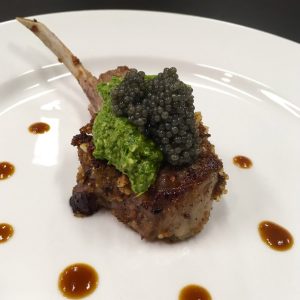calsfoundation@cals.org
Caviar
Arkansas caviar, which is distributed nationally, consists of eggs from certain freshwater fish caught in the state’s rivers. The commercial fishermen who supply the product to wholesalers generally obtain the eggs from the Arkansas, Mississippi, White, Cache, and St. Francis rivers in eastern Arkansas from late November until early April. The eggs come from paddlefish (commonly referred to in the Arkansas Delta as spoonbill catfish), shovelnose sturgeon, and bowfin. Armenian brothers Melkoum and Mouchegh Petrossian often are credited with popularizing caviar in Paris, France, in the 1920s and spurring a worldwide interest in the product.
Paddlefish eggs make up the majority of the Arkansas caviar that is harvested. Paddlefish can be distinguished by their large mouths and elongated snouts, called the rostrum. Paddlefish, which can live for fifty years or more, commonly reach five feet or more in length and can weigh more than sixty pounds. The traditional range of paddlefish has been the Mississippi River watershed, including its major tributaries such as the Missouri River and the Ohio River.
Commercial fishing once played an important role in the Arkansas economy, especially in the Delta. Hundreds of Arkansans lived on houseboats on the lower Arkansas, White, Cache and St. Francis rivers, trying to make a living catching fish, trapping for furs, and gathering mussel shells for the button industry. For many years, commercial fisherman considered paddlefish a “trash fish.” Later, however, paddlefish were sometimes sold under the false moniker “sturgeon.”
With the decline of the button industry, many of the Arkansans who worked on the rivers began to concentrate on selling catfish and bigmouth buffalo fish to restaurants and wholesalers. In recent decades, however, most restaurants have stopped using commercially caught catfish, choosing instead to buy farm-raised catfish because of its milder taste. As the demand for commercially caught fish declined, some fishermen began harvesting caviar for the first time.
Jessie George of Marvell (Phillips County) started his caviar business in 1998 and is one of the largest wholesalers of Arkansas caviar, at one time shipping almost 10,000 pounds of eggs annually. By 2013, George reported that he was shipping about 5,000 pounds annually, the decrease due not to a lack of eggs but instead to the difficulty of finding seasonal labor to process those eggs.
While caviar has never been a staple in the United States, it is often found in fine dining establishments. With increased restrictions on the harvest of eggs from certain saltwater species, the demand for freshwater caviar has grown. One buyer of Arkansas caviar is the Great Atlantic Trading Company of Ocean Isle Beach, North Carolina. Its website describes paddlefish roe as ranging from “light to dark steel gray, and comparable in taste to Caspian Sea Sevruga.” The eggs from shovelnose sturgeon generally are listed for commercial purposes as hackleback caviar and are described as “dark, firm with a very mild, subtle flavor.” The website promotes bowfin eggs as a “black caviar roe with an earthy and distinctive flavor that make a good, less expensive substitute for sturgeon caviar.”
The range of the paddlefish has been greatly reduced in recent years by overfishing, drainage projects, and the damming of streams. Poaching has also been a problem in some surrounding states, as there is a black market for caviar. Warsaw, Missouri, calls itself the “paddlefish capital of the world,” but officials there recently had to restock streams. Paddlefish populations appear to be stable in Arkansas.
For additional information:
Caviar Star. http://www.caviarstar.com/ (accessed October 27, 2021).
Nelson, Rex. “The Caviar King.” Arkansas Life, July 2012, pp. 43–45.
Sutton, Keith B. Fishing Arkansas: A Year-Round Guide to Angling Adventures in the Natural State. Fayetteville: University of Arkansas Press, 2000.
Rex Nelson
Arkansas’ Independent Colleges & Universities
 Divergent Prosperity and the Arc of Reform, 1968–2022
Divergent Prosperity and the Arc of Reform, 1968–2022 Food and Foodways
Food and Foodways Paddlefish Roe
Paddlefish Roe 




Comments
No comments on this entry yet.